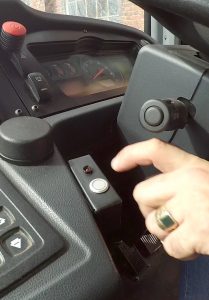Vehicle rollaway can have potentially devastating consequences for both drivers and operators, especially when the heavy loads that commercial vehicles can carry is factored in. CVW spoke with Vision Techniques Technical Manager Nigel Armstrong to learn more about its safety system designed to prevent these accidents from happening.
Q. What are rollaway and runaways?
A. Runaways and rollaways occur when the driver is not in the vehicle and either the truck or trailer parking brakes, or both, are not applied. A runaway is a situation where a truck or truck-and-trailer moves in an uncontrolled manner. A rollaway is where a trailer moves in an uncontrolled manner, independent of the truck.
Q. Why do they happen?
A. With all the other demands on a driver and the pressure of intensive operations, it’s all too easy to forget a basic precaution such as applying the parking brake or to follow correct tractor- trailer coupling procedures.
Should the driver have forgotten to apply the park brake, a runaway is all too feasible. On tractor-trailer combinations, failure to apply the brakes risks rollaway when the brake line is disconnected. Conversely, the whole rig could run away when the red airline is connected. The driver in these situations is in a particularly vulnerable position – either between the rear of the tractor unit and front of the trailer, or at the side, unable to apply the brakes.
Case StudyBritish Gypsum is the first company to fit BrakeSafe. Starting with 35 vehicles, it is now rolling out BrakeSafe across 300 vehicles at selected sites as part of its zero harm risk target. “It is the first time, I am aware of, that you can actually have a trigger that is recorded, that tells you when the handbrake has not been applied, and whether there is potential for rollaway”, says Kirk Ennis from British.
Q. How does BrakeSafe prevent this happening?
A. Other systems provide an audible warning to the driver that the park brake has not been applied, but BrakeSafe is the only system that will actually prevent a runaway from happening – the system automatically applies the vehicle handbrake if the driver forgets.
The system is autonomous; the driver does not have to press, look or interact with the safety system at all when driving. It’s only activated if a potential rollaway incident occurs, so, in daily operations, drivers won’t notice it is there.
Multiple sensors have to be activated in a certain scenario for the BrakeSafe system to apply the brakes. These include door position, whether the vehicle is running, and if the driver is sitting on the seat. The system is programmed to activate when needed, but not to interfere with the driver if not all aspects of the scenario have been met.
If the signals are all active and the brakes are released, BrakeSafe will instantly apply the handbrake and caution the driver with an audible warning.
The system automatically takes control, even with the ignition off, eliminating any risk of vehicle rollaway and preventing serious and even fatal accidents. It also applies the handbrake if, for whatever reason, the air pressure drops within the brake line, which can also cause a runaway.
Q. What happens if BrakeSafe develops a fault?
A. BrakeSafe is designed to failsafe – its in-built condition monitoring system checks mechanical, sensor and control systems and if any do develop a fault, the system will not activate. This ensures the braking system on the vehicle is not compromised and prevents false alerts.

Q. How long does installation take?
A. For retrofits, Vision Techniques engineers can install the system on- site and even train your own technicians in the correct procedure. It’s a straightforward job – a solenoid valve is fitted to the air supply line to the park brake, and pressure switches installed at appropriate points.
There is no impact on braking dynamics, but because it represents a change to the vehicle’s Type-Approved braking system, a VTG10 notifiable alternation must be completed. The Vehicle Certification Agency has already certified BrakeSafe as compliant, so it’s a simple paperwork exercise.
Q. What about maintenance?
A. The unit is very robust and there is little to develop a fault. We advise incorporating a function check into drivers’ daily walk-round checks and routine service checks.
It’s also possible for managers to confirm the system is operating correctly or has been activated via a data input feed either to an existing telematics system on the vehicle, or to Vision Techniques VT- Connect remote monitoring system.
Q. Why don’t more people have rollaways?
A. Vehicle rollaways are often only reported when they cause loss of life or serious damage. Many runaways happen in depots but most are not reported at all. It’s the iceberg effect; we only hear of a fraction of rollaways in comparison to how many happen each day. To cause major damage, or even kill someone, all it takes is a driver to forget the handbrake in a public place.










